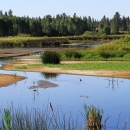The National Fish Habitat Partnership is a national investment strategy designed to maximize the impact of conservation dollars on the ground. Funds are leveraged through regional partnerships to address the nation’s biggest fish habitat challenges and projects are identified and completed through a network of 20 regional Fish Habitat Partnerships. These partnerships leverage federal, state, tribal, and private resources to achieve the greatest impacts on conservation.
How the National Fish Habitat Partnership program works.
The work is voluntary. – The National Fish Habitat Partnership program takes a voluntary, non-regulatory, approach to address the nation’s fish habitat conservation challenges.
Funding is leveraged to maximize results. – Under National Fish Habitat Partnership, federal, state, tribal, and privately raised funds are leveraged to address the nation’s biggest fish habitat challenges. In 2019, limited federal funding from the Service was leveraged by more than 3 to 1 with funds from other partners.
Conservation gains grow the economy and protect against climate. – The network of Fish Habitat Partnerships drive local job creation through direct funding investments and build more resilient infrastructure that can better withstand climate change climate change
Climate change includes both global warming driven by human-induced emissions of greenhouse gases and the resulting large-scale shifts in weather patterns. Though there have been previous periods of climatic change, since the mid-20th century humans have had an unprecedented impact on Earth's climate system and caused change on a global scale.
Learn more about climate change . Often, the same barriers that hurt fish, like undersized culverts in road crossings, can also harm communities. Undersized culverts can block fish passage fish passage
Fish passage is the ability of fish or other aquatic species to move freely throughout their life to find food, reproduce, and complete their natural migration cycles. Millions of barriers to fish passage across the country are fragmenting habitat and leading to species declines. The U.S. Fish and Wildlife Service's National Fish Passage Program is working to reconnect watersheds to benefit both wildlife and people.
Learn more about fish passage and prevent them from being able to move freely to find food, shelter, and reproduce. They can also cause water to back up behind the crossing during storms, often leading to culvert failure and severe road damage.
Get Started
How do I apply for funding?
All project proposals must be submitted through a Fish Habitat Partnership. Please visit Fish Habitat Partnership webpages to determine how your project may align with the goals and objectives of a particular Fish Habitat Partnership. Most Fish Habitat Partnerships solicit project proposals via an annual Request for Proposals.
How are projects selected for funding?
Project selection is locally driven. The Service distributes limited federal funding to Fish Habitat Partnerships for operations and through a competitive, results-driven process for fish habitat conservation projects. Fish Habitat Partnerships then use the funding they are allocated on fish habitat conservation projects they have identified and prioritized.
